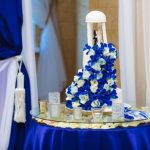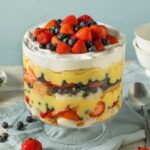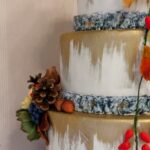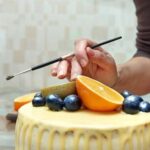Edible glue is an essential component in the art of cake decorating, allowing for the secure attachment of various edible decorations onto cakes. In this article, we will explore how to make edible glue for cake decorating and its significance in creating beautifully adorned confections. Whether you’re a seasoned baker or just beginning to dabble in cake decoration, understanding the different types of edible glues and how to make them can vastly improve the overall outcome of your creations.
When it comes to adorning cakes with intricate designs and delicate details, using the right type of adhesive is crucial. Edible glue offers a safe and reliable way to affix fondant, gum paste flowers, sugar pearls, and other decorative elements without compromising the taste or quality of the finished product. This introductory section will provide an overview of the importance of using edible glue in cake decorating and delve into the various types commonly utilized by bakers and decorators.
Additionally, we will discuss alternative ingredients for making edible glue to accommodate individuals with dietary restrictions or allergies. By exploring different recipes and methods for creating edible glue, you can ensure that your creations are not only visually appealing but also suitable for those with specific dietary needs. Stay tuned as we guide you through the process of crafting your own edible glue while providing valuable tips for its application on various types of cakes.
Ingredients for Making Edible Glue
When it comes to cake decorating, using the right adhesive is crucial for ensuring that your decorations stay in place. Edible glue is a popular choice among bakers and cake decorators, as it provides a safe and effective way to attach fondant, gum paste, and other edible decorations to cakes. Making your own edible glue at home is not only cost-effective but also allows you to customize the ingredients based on any dietary restrictions or allergies you may have.
To make a simple and versatile edible glue, the basic ingredients you will need include water and tylose powder. Tylose powder is a food-grade additive that helps thicken and stabilize the glue, making it ideal for use in cake decorating. These two ingredients are commonly used in most edible glue recipes due to their effectiveness and ease of use.
For those with dietary restrictions or specific preferences, there are alternative ingredients that can be used to make edible glue. For example, if you prefer a vegan option, you can substitute tylose powder with agar-agar powder, which is derived from seaweed. Additionally, xanthan gum can also be used as a thickening agent instead of tylose powder for those who prefer gluten-free options.
Experimenting with different ingredients can help you tailor your edible glue to suit your specific needs while still maintaining its adhesive properties. By understanding the basic ingredients and their alternatives, you can easily create a customized edible glue that aligns with your dietary requirements.
Measuring out the correct proportions of these ingredients is essential in creating an effective adhesive solution for cake decorating. Understanding how to make edible glue for cake decorating is not only beneficial for adhering decorations but also offers peace of mind knowing exactly what is going into your creation. With these alternative ingredient options available, everyone can enjoy creating beautiful cakes without compromising personal dietary needs or preferences.
Step-by-Step Guide to Making Edible Glue
Making edible glue for cake decorating is a simple and essential skill for any baker or cake decorator. Whether you’re working with fondant, gum paste, or other edible decorations, having a good quality edible glue can make the difference between a beautiful cake design and a potential disaster. In this step-by-step guide, we will walk you through the process of making your own edible glue for cake decorating.
The basic ingredients needed to make edible glue are water and tylose powder. Tylose powder, also known as CMC (carboxymethyl cellulose), is a thickening agent that is commonly used in baking and cake decorating. To make edible glue, simply mix 1 teaspoon of tylose powder with 1/4 cup of warm water. Stir the mixture until the tylose powder has completely dissolved, and then let it sit for about an hour to allow it to thicken.
For those with dietary restrictions or allergies, alternative ingredients can be used to make edible glue. For example, if you have a gluten allergy or sensitivity, you can use xanthan gum instead of tylose powder. Xanthan gum is a common gluten-free thickening agent that can be used as a substitute in edible glue recipes.
Once your edible glue has thickened, it is ready to use for cake decorating. When using your homemade edible glue, it’s important to apply it sparingly with a small brush or toothpick to avoid excess moisture on your decorations. Proper storage of your homemade edible glue is also crucial in maintaining its quality and effectiveness.
Store it in an airtight container at room temperature away from direct sunlight to ensure its longevity. By following these simple steps and tips on how to make edible glue for cake decorating, you can elevate your cake designs and create stunning works of art that are not only beautiful but also safe to eat.
Tips for Using Edible Glue in Cake Decorating
Edible glue is a crucial element in cake decorating, as it allows for secure attachment of various decorations to the cake. Whether you are working with fondant, gum paste, or even wafer paper, edible glue is essential for achieving professional-looking and long-lasting results. There are different types of edible glues commonly used in cake decorating, such as royal icing, gum glue, and tylose glue. Each type has its own unique properties and suitability for different decorating techniques.
When it comes to using edible glue in cake decorating, there are several tips and tricks that can make the process easier and more effective. Firstly, it’s important to use the right consistency of edible glue for the task at hand.
For intricate details and fine decorations, a slightly thicker glue may be preferable to ensure better control during application. Additionally, when attaching larger or heavier decorations to the cake, applying a generous amount of edible glue and allowing it to set before handling further can help prevent them from sliding or falling off.
Proper storage of edible glue is also key to ensuring its longevity and performance. Store your homemade or store-bought edible glues in a cool, dry place away from direct sunlight. Keep them tightly sealed when not in use to prevent drying out or contamination.
Lastly, knowing which type of edible glue works best with different materials can greatly impact the outcome of your cake decorations. Some edible glues may work better with fondant while others are more suited for gum paste or wafer paper.
| Edible Glue Tip | Description |
|---|---|
| Consistency Matters | Use appropriate consistency based on the size and weight of the decoration |
| Storage | Store in a cool, dry place away from sunlight in tightly sealed containers |
| Material Compatibility | Select the right type of edible glue for specific materials like fondant or gum paste |
Alternative Uses for Edible Glue
Edible glue isn’t just limited to cake decorating – it can actually be used in a variety of creative ways in the realm of baking and decorating. One alternative use for edible glue is in creating intricate gingerbread houses during the holiday season.
This versatile adhesive can securely hold together the walls, roof, and decorative candies, allowing for a more stable and visually appealing gingerbread house. Furthermore, edible glue can also be used to attach various edible embellishments to desserts such as cookies, cupcakes, and even chocolate truffles.
Another surprising use for edible glue is in the assembly of edible sculptures made from ingredients like sugar paste or modeling chocolate. By using edible glue as an adhesive, bakers and confectioners can construct elaborate and eye-catching centerpieces for special occasions or events. Additionally, they can also effectively assemble fondant pieces for unique cake toppers or decorations. Edible glue provides a strong hold without affecting the taste or appearance of the finished product.
Outside of traditional baking applications, edible glue has also found its way into various do-it-yourself crafting projects. For instance, it can be used to create edible mosaics on cookies or cakes by carefully attaching tiny pieces of fondant or gum paste with the help of the adhesive properties of the edible glue.
Additionally, it can be used as an alternative to regular glue in creating food-safe crafts such as gingerbread ornaments or other decorative items meant for consumption.
Edible Glue Recipes for Different Types of Cakes
Edible Glue for Fondant Cakes
When decorating fondant cakes, it is essential to have a reliable edible glue that can securely attach decorations without compromising the smooth surface of the fondant. To make edible glue for fondant cakes, you will need 1 cup of confectioner’s sugar, 1-2 tablespoons of water, and 1 teaspoon of tylose powder.
Start by mixing the tylose powder with the water until it becomes a paste, then gradually add the confectioner’s sugar until the desired consistency is achieved. This edible glue can be used to attach fondant details such as flowers, figurines, and other embellishments to your cake.
Edible Glue for Buttercream Cakes
For buttercream cakes, a slightly different type of edible glue is needed to ensure that decorations stay in place without causing any damage to the delicate buttercream frosting. To make edible glue for buttercream cakes, combine 1/4 cup of light corn syrup with 1/4 teaspoon of clear vanilla extract. Stir the mixture until well combined and use it to adhere decorations like sprinkles, nonpareils, or small chocolate pieces onto your buttercream cake.
Vegan-Friendly Edible Glue Recipe
For those with dietary restrictions or preferences, it is possible to make a vegan-friendly edible glue using simple ingredients that do not compromise on effectiveness. A basic recipe for vegan-friendly edible glue includes 2 tablespoons of agar-agar powder and 6 tablespoons of hot water.
Dissolve the agar-agar powder in hot water and allow it to cool before using it as an adhesive for cake decorations. This vegan-friendly option provides a suitable alternative for individuals who follow a plant-based diet or have dairy or egg allergies.
By following these specific recipes for different types of cakes and dietary needs, you can create your own homemade edible glue for cake decorating that ensures both safety and professional-looking results.
Troubleshooting Common Issues With Making Edible Glue
When making edible glue for cake decorating, it’s essential to know how to troubleshoot common issues that may arise during the process. Here are some common problems you might encounter and their solutions:
- Edible Glue Too Thin or Runny
- Edible Glue Too Thick or Clumpy
- Edible Glue Not Adhering Properly
If your edible glue turns out too thin or runny, it may not hold your cake decorations in place. To fix this issue, you can add a small amount of powdered sugar to thicken the glue. Start with a teaspoon of powdered sugar and gradually mix it into the glue until you reach the desired consistency.
On the other hand, if your edible glue is too thick or clumpy, it may be challenging to work with and could result in a messy appearance on your cake. In this case, try adding a few drops of water or corn syrup to thin out the glue. Mix it well and continue adding small amounts of liquid until the glue reaches a smooth, spreadable consistency.
Sometimes, edible glue may not adhere properly to your cake decorations. This can be frustrating, but there are ways to troubleshoot this issue. First, ensure that both the surface of the decoration and the area where you want to attach it on the cake are clean and free from grease or moisture. You can also lightly score both surfaces with a toothpick before applying the edible glue to create better adhesion.
By addressing these common issues with making edible glue for cake decorating, you can ensure that your decorations stay securely in place and your finished product looks professional and polished.
Conclusion and Additional Resources
In conclusion, learning how to make edible glue for cake decorating is a valuable skill for any baker or decorator. By understanding the importance of using edible glue and familiarizing oneself with the different types of edible glue available, one can elevate their cake decorating techniques and achieve professional-looking results.
With the right ingredients and a step-by-step guide, making edible glue at home is both simple and cost-effective. Additionally, the flexibility to customize recipes for specific dietary needs or preferences makes edible glue a versatile tool in the world of baking and decorating.
As mentioned in this article, it is crucial to carefully follow the step-by-step guide to making edible glue, ensuring accurate measurements and thorough mixing. By closely adhering to these instructions, decorators can avoid common issues that may arise during the process. Furthermore, additional tips for storing and using edible glue will help decorators achieve optimal results when applying decorations to cakes.
For those interested in delving deeper into the world of cake decorating with edible glue, there are numerous additional resources available. Whether it be video tutorials demonstrating application techniques or alternative uses for edible glue in baking beyond cake decoration, there is plenty of information to explore. Understanding the versatility and practicality of homemade edible glue will undoubtedly inspire decorators to unleash their creativity and take their cake designs to new heights.

Welcome to my blog about home and family. This blog is a place where I will share my thoughts, ideas, and experiences related to these important topics. I am a stay-at-home mom with two young children. I hope you enjoy reading it! and may find some helpful tips and ideas that will make your home and family life even better!





